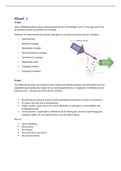Summary
Summary - Methodology, Measurement And Statistics For PM Students (424023-B-6) - METHODOLOGY PART
- Course
- Institution
- Book
This summary is a combination of content both from the Social Research book and the lectures given by Luc van Baest. However, this summary focuses on the Methodology part of the MMS course so I recommend you take a look at the bundle that includes all three summaries (Statistics, Methodology & S...
[Show more]





